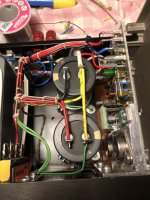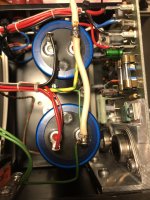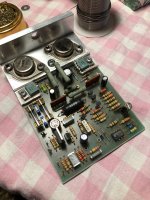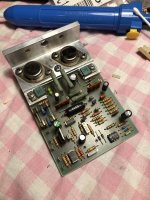I’m helping a friend refurbishing his newly acquired 405-2 amplifier. It has had prior work, capacitors replaced at various points in its life, new speaker terminals and cabling from the negative speaker terminals replaced. I’ve now replaced the all capacitors on the boards with Nichicon PW & an UKL instead of the tantal, two Nichicon KG Super Through for the PSU. Both R7/R8 have been replaced with 1w resistors. After testing I now have a low level hum on both channels, I would say it’s around 100khz, so guess it’s rectified. It’s only noticeable when pressing your ear close to the midrange. I did some testing before doing work on it, but didn’t notice the hum then, not sure if it was there or not since I didn’t listen that closely. DC-offset was low and still is, 0.45mV and 1.5mV respectively. I’ve checked all grounding and as far as I can tell it’s all good. Can the new routing of the cabling cause this interference? Some before and after shots.
Attachments
It is possible, particularly if something like the input cabling is routed near something carrying high peak currents such as the PSU wiring. The peak rectifier currents even when idling are very high and that can radiate from the wiring and be induced.Can the new routing of the cabling cause this interference?
Try with both inputs shorted and nothing else apart from speakers connected.
Not familiar with the amp so ok to ignore...
I'd be leaning towards ignoring the problems subject to test equipment availability, ie, do you have an oscilloscope, if so confirm 100Hz hum rather than 50Hz (mobile phone apps can do this). If 100Hz then I'd be checking for "excessive" ripple on any regulated psu, ie, a tired transistor/regulator. Rule out PSU if it feeds both channels and hum only in one.It’s only noticeable when pressing your ear close to the midrange.
I'm working on my Quad 405-2 hum as well. One thing I found after disconnecting both amplifier board is that.... The hum is still there.
This leads to 3 possibilities.
#1 Transformer shot... (hopefully not)
#2 Rectifier bridge shot... (cheapest to fix)
#3 Large filter capacitor shot... (Annoying, but not hard to get good parts to replace it.)
I disconnected power and found negative rail drained VERY quickly, dropping to 17V and lower very quickly, while the positive rail remained at 54V for a very long time.
I then tested the bridge rectifier with my bench power supply, with up to 26V reverse voltage, the bridge rectifier still does not have any measurable current, looks like the bridge is holding fine. (the bridge was removed from circuit for the test.
That left the capacitor to be tested, I'll be hooking up the bench power supply to it later today and see. The negative rail capacitor might be shot, or there could be a flaky short somewhere on the negative rail wiring (I feel that's unlikely).
This leads to 3 possibilities.
#1 Transformer shot... (hopefully not)
#2 Rectifier bridge shot... (cheapest to fix)
#3 Large filter capacitor shot... (Annoying, but not hard to get good parts to replace it.)
I disconnected power and found negative rail drained VERY quickly, dropping to 17V and lower very quickly, while the positive rail remained at 54V for a very long time.
I then tested the bridge rectifier with my bench power supply, with up to 26V reverse voltage, the bridge rectifier still does not have any measurable current, looks like the bridge is holding fine. (the bridge was removed from circuit for the test.
That left the capacitor to be tested, I'll be hooking up the bench power supply to it later today and see. The negative rail capacitor might be shot, or there could be a flaky short somewhere on the negative rail wiring (I feel that's unlikely).
The service manual shows that the power on LED (and LED + series 2k7 resistor) is fed from the + rail and so in a way that should fall first and certainly shouldn't be the rail to remain at +54 volts when you power it off. It all depends how its wired though.
So the hum is mechanical... surely that has to be the transformer.
If you have nothing at all connected to the reservoir caps and one isn't holding a charge then it looks as though that cap has to be faulty.
I'm working on my Quad 405-2 hum as well. One thing I found after disconnecting both amplifier board is that.... The hum is still there.
So the hum is mechanical... surely that has to be the transformer.
If you have nothing at all connected to the reservoir caps and one isn't holding a charge then it looks as though that cap has to be faulty.
There can be 3 common ways that transformer can hum.The service manual shows that the power on LED (and LED + series 2k7 resistor) is fed from the + rail and so in a way that should fall first and certainly shouldn't be the rail to remain at +54 volts when you power it off. It all depends how its wired though.
So the hum is mechanical... surely that has to be the transformer.
If you have nothing at all connected to the reservoir caps and one isn't holding a charge then it looks as though that cap has to be faulty.
#1. Bad transformer.
#2. DC current exist in some of the windings.
#3. Overload.
I'm trying to exclude #2 and #3 before considing about any transformer replacement, as that's the most pain it the butt thing to do with Quad 405... It would either a pain the the wallet or a pain in the neck trying to work and fix the transformer.
#2. Likely isn't an issue, as the rectifier seems to be holding fine at a voltage way higher than the rapid discharge I see on the capacitor.
#3. could be true, and I'm going to test the caps later today and see. I'm really hoping I can save those nice BHC/Aerovox caps, but if not, maybe I'll get some nice Kemet/BHC or Nichicon KG caps. I'll also fire up the transformer with secondary winding not connected to anything and see about any noise.
One note about the caps tho... They are rated to 63V only, that really is too close to the 54V rail voltage I see when I was testing it. If I do end up replacing them, I think 80V is the lowest I'll go.
If you disconnect the yellow secondary wires that go to the rectifier and it still hums then its almost certainly the transformer, this is a common problem.
Stuart
Stuart
Did some more test and it seems the caps are looking to be good. Then I found some of the transformer screws could be tightened a little bit, it was a bit looser than the reasonable tightness.
Looks like it is the transformer all along, but does hum a tiny bit less after tightening and I'll see if it becomes unnoticable after it is all put back together. I guess I was hoping for too much when trying to figure it out, it was always the transformer... hahaha
In the mean time, I'm trying to take some measurement of the transformer mounting, I've seen some rather nice dual C-core transformer that should fit the space, and I'm trying to get the dimention of it as well as the mounting screw location on my Quad 405-2... some spot are really hard to measure...
Looks like it is the transformer all along, but does hum a tiny bit less after tightening and I'll see if it becomes unnoticable after it is all put back together. I guess I was hoping for too much when trying to figure it out, it was always the transformer... hahaha
In the mean time, I'm trying to take some measurement of the transformer mounting, I've seen some rather nice dual C-core transformer that should fit the space, and I'm trying to get the dimention of it as well as the mounting screw location on my Quad 405-2... some spot are really hard to measure...
Last edited:
Transformer hum often varies with the time of day as the actual mains voltage and its purity can make a big difference.
Yup, also found that it was somewhat amplified by the chassis, kinda like a drum... Tightening it reduced the resonance and I didn't even need to add any dampening material.Transformer hum often varies with the time of day as the actual mains voltage and its purity can make a big difference.
After fixing all that, the hum was tolerable, as I need to be really close (under 30cm) to hear it. Then when I test it, one channel have over 40mV of DC, while the other one blows the DC power rail fuses... (it was working before, with the class A section getting rather warm while bench testing for the hum) Swapped the fuse with same spec 4A fast acting fuse... instantly blown.
I'll admit defeat and let it rest for a bit, until the frustration dies down a bit... hahahaha... Then I'll see about maybe fixing it....
Swapped the fuse with same spec 4A fast acting fuse... instantly blown.
That doesn't sound good 🙁 I would use a bulb tester while fault-finding. The channel with 40mv also doesn't sound good. It should be pretty close to zero as the 405 uses the opamp to set the DC operating points. Perhaps the 40mv is actually a problem with high frequency oscillation rather than a DC fault.
That's why I threw in the towel for now, maybe later when I get my hands on a cheap oscilliscope and can see what exactly is going on. I don't have a dim bulb tester and wasn't planning on one, as the unit was fine other than the hum before I opened it up. Maybe I screwed up something or left something conductive somewhere it shouldn't be.That doesn't sound good 🙁 I would use a bulb tester while fault-finding. The channel with 40mv also doesn't sound good. It should be pretty close to zero as the 405 uses the opamp to set the DC operating points. Perhaps the 40mv is actually a problem with high frequency oscillation rather than a DC fault.
Then again, the lousy TL071 might also be at fault.... I have a pretty big stash of OPA6237AP and BP, will swap it on after I'm sure the board is all good, ain't gonna try to run smoke test with those op-amps... 😛
For the opamp I was thinking about that it could be the cause of that 40mV DC offset.It won't be the op-amp. You have a shorted power transistor.
For the insta-boom fuses, you might be right... However, never rule out my clumsy hands dropped something on the board and causing a short... Hahaha, but blowing both fuses at the same time, does sound little like something a shorted power transistors might do well.
An idea just stuck me when i was browsing the local thrift store... There are many many receivers that sells for next to nothing, and the power rating is pretty close to 405 in per channel term... Perhaps i could just get a transformer from one of those, instead of trying to get someone to custom make me one.
After some simple digging, i found Yamaha HTR-6080 have similar voltage, and should have much higher current capability. Then there's a Integra DTM-5.3... exact same rectified/filtered DC voltage as Yamaha(57V DC)...
Looks like transformers from 100W(8 Ohm)/channel receivers are likely to have the right voltage to work in 405.
Now maybe I'll go to thrift store with a cardboard template for 405's transformer, and see if i can just score a replacement transformer at higher rating, plus a pile of nice spare parts for cheap.
After some simple digging, i found Yamaha HTR-6080 have similar voltage, and should have much higher current capability. Then there's a Integra DTM-5.3... exact same rectified/filtered DC voltage as Yamaha(57V DC)...
Looks like transformers from 100W(8 Ohm)/channel receivers are likely to have the right voltage to work in 405.
Now maybe I'll go to thrift store with a cardboard template for 405's transformer, and see if i can just score a replacement transformer at higher rating, plus a pile of nice spare parts for cheap.
Last edited:
- Home
- Amplifiers
- Solid State
- QUAD 405-2 low level hum



